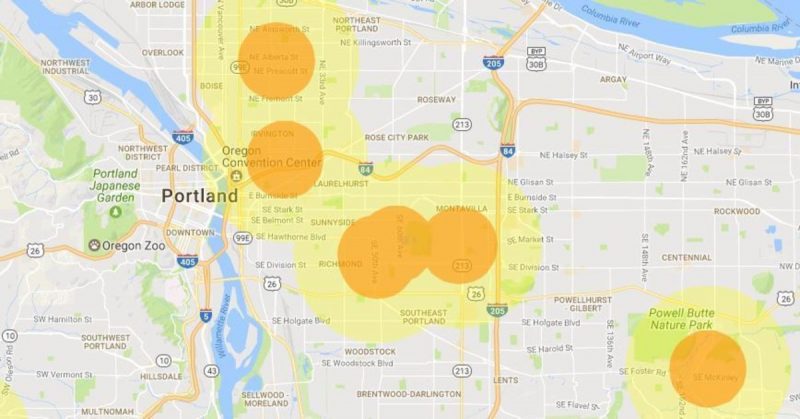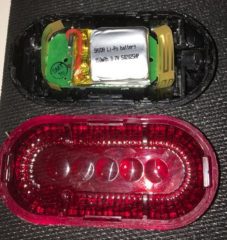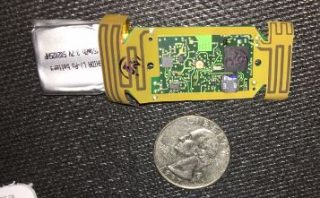
(Photos: Bryan Hance/The Bike Index)
BikePortland subscriber and resident bike theft expert Bryan Hance from The Bike Index checked out the Iota Tracker with an eye towards bike tracking, DIY hacking, and more.
We field a lot of questions about ‘bike trackers’ at the Bike Index – everybody wants a small, affordable GPS tracker for their bike. Sounds like a simple request; but many people are surprised to learn a product like this doesn’t exist yet.
There are a few basic reasons why trackers aren’t as great as you think:
Size/hideability — It is hard to disguise a tracker so thieves can’t instantly find it. And having something that uses several antennas (GPS and cellular) means they aren’t easily hidden – nor are they very small.
Reliance on cellular — Most trackers use the cellular network to report their location, which means most trackers are 50% cell phone parts – and means paying for cell data, supporting a SIM card, having a hefty battery, etc.
Power — Because of #2, power is an issue. Nobody wants to constantly have to charge a tracker, but once you’ve gone with cellular there’s really no way around this. Talking to the cell network takes a fair amount of power, end of story.
For a while I was excited about the low-power bluetooth trackers – especially the ‘crowd tracking’ capabilities, but my own tests with these have been disappointing. And while there are a lot of smart people out there working in the bike-tracking space, most of them are just pending Kickstarters with no real product on the market.
The Iota Tracker – a totally different approach
The Iota Tracker really piqued my interest – yes, it’s a GPS tracker, but it doesn’t use the cellular network. Instead, Iota uses RF frequencies and a ‘community network’ of tiny base stations to report its position.
This completely upends the equation I listed above, eliminating problems #1 and #3 by getting rid of #2. The results is a small, versatile tracker with a significantly longer battery life.
Iota has been mostly focused on pet and child tracking, but there’s obviously a lot of potential here for tracking bikes. After a week of tests with my hands on an Iota, I see a whole lot of potential for bike tracking – and hackability.
The Iota Network

Just to recap how Iota’s tracking works:
Iota users get a small ‘base station‘ to install for local coverage – Iota’s website base stations cover ‘up to 12 blocks from your home’ but as with all things RF-related, your mileage may vary – especially in dense urban environments. Think of it like the original cordless phones – remember how much range you could get with some of those? Same thing applies here.

All the Iota base stations in a location form a patchwork ‘blanket’ of coverage, so when your Iota leaves your home station’s coverage it can still report in via someone else’s base station. It’s basically like a baby cellphone network – but dedicated to tracking.
You can see the current coverage map on Iota’s site – Iota is based in the Bay Area, so the San Francisco coverage map is very dense, while Portland is a little patchier. Yes, Iota’s coverage network is still being built – customer by customer – but you can see that it wouldn’t take many more to blanket a town like Portland.
Bluetooth backup: The Iota also does ‘crowdsourced Bluetooth tracking’, meaning that if someone near your Iota is running the Iota app, it’ll report its position that way – instead of using the base stations. This is how most of the small trackers already on the market operate, but it’s totally dependent on that nearby cellphone to be running the app, and typically only gets a few dozen feet of range under even the best of conditions.
The tracker
First impression? The Iota tracker is small. Really small, as you can see here. At 1.75in x .5 x 1in , the Iota looks and feels like a small domino. And it weight about as much as a AAA battery.
Speaking of batteries, I’ve had this tracker for over two weeks now and I’ve only used half the battery life. Iota promises ‘weeks’ of battery life, which, compared to everything else available in the tracking sphere, is a huge improvement.
There’s a small USB adapter provided for charging the Iota, via two small charging points on the back of the tracker. Some folks have already used an adaptor to provide perpetual power.
The app, tracking, and real-world tests
Iotas are tracked via an app, and there’s the usual set of tracking options you would expect, such as: current location; live tracking; location history; ‘ring’ – makes the Iota tracker emit a beep; geofencing – receive an alert it the tracker leaves a certain area; motion alerts – receive an alert it the tracker is moved/jostled; signal/gps/battery strength.
You can also ‘share’ your Iota’s location and data with another Iota user, and they can view, track, beep and operate a shared Iota just like it is their own.
The app also handles ‘out-of-range’ scenarios well: If your Iota’s out of range, you can set the app to alert you when it pops up again.
If you’re like me, your bike-tracking ‘spidey sense’ should be tingling by now …
I carried an Iota around for a week, testing it out its range and trackability – I’d walk various parts of Portland and test the locate, track, and beep functions, just to get an idea of how well the Iota worked in real-world scenarios.
The results? Pretty good – sometimes surprisingly good. Case in point: Even while sitting on the bus – surrounded by glass and metal, moving – my Iota was getting ‘hits’ on the network and was trackable.
There’s no coverage in downtown Portland at the moment, but again, judging from the Iota coverage map it looks like Portland could be covered with a fairly small number of new base station additions.
Let’s hack this thing
Speaking of potential … let’s talk hackability for a sec.
The street, as someone once said, finds its own use for things – and bike folks are natural tinkerers. So, I cracked my Iota open with the idea that I’d love to hack one into a more bike-friendly form – camouflaged? Better powered? Sure – let’s see what we have to work with first.
As you can see the Iota’s three tiny parts – circuit board, battery, antennas – are all super small, fairly modular (in the right hands), all begging for some hands-on hacking. That battery could be swapped out for a larger one fairly easily, for example, or powered off of a bike light. Or sandwiched inside a reflector. Those antennas could be worked into a stem cap. In short: Lots of potential here!
Just for the heck of it, and to provide a potential example here – I cannibalized an old bike light, and in about six seconds I had a nicely camouflaged Iota tracker — with lots of room left for spare batteries. Imagine the tracking life we could get out of two AAA’s already inside the light…
Final thoughts
After a week with an Iota, my head’s brimming with ideas: If I had a cargo bike, this would be a no-brainer. I want some hardware-centric friends to try and piggyback extra batteries on one. I’d like to camo one out in black, so it’s not super recognizable. I want to see if I can fit inside my handlebars, antennas fitted into an end cap. I have several acquaintances who have had tool trailers stolen here in Portland – I’d like to try and bake one into a tail light and power it that way. And I want to get some nerdy friends to help build out the network of base station ‘nodes’. The list goes on…
Honestly the Iota hardware is so small that it looks like it could be a huge boost to someone looking to add small, low-power tracking to … well, anything, really. And that’s pretty huge.
The Iota retails for $149 – that’s 1 base station and 1 tracker. Which, admittedly, is a little steep for most folks, but the lack of recurring payments (for phone data) should help smooth that out for people. They aren’t selling individual trackers yet, but I suspect it’s in the pipeline, which would likely drop the price significantly.
Thanks for reading my review. I’m looking forward to watching the Iota network grow both in Portland and across the U.S.
Post submitted through our Subscriber Post service. Also posted at BikeIndex.org.
— Bryan Hance: @stolenbikereg
BikePortland is supported by the community (that means you!). Please become a subscriber or make a donation today.


